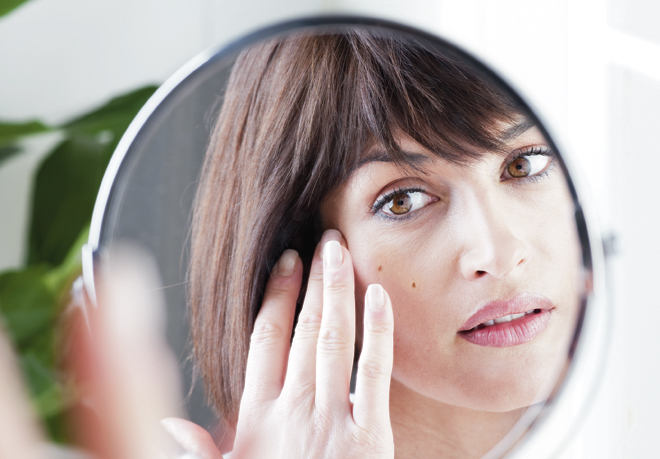
By Janet Thompson –
Age spots (aka “liver spots” and “solar lentigines”) are flat tan, brown, or black spots that appear on the skin, typically in those who are older than 50. Younger people can get them too depending on how much time they spend in the sun.
They vary in size and usually appear on the face, hands, shoulders and arms – these are the areas most exposed to the sun. The constant exposure of ultraviolet (UV) light, the use of commercial tanning lamps and tanning beds are major contributors to the development of age spots.
What Causes Age Spots?
Age spots occur when the top surface layer of skin expands with more pigment and develops what looks like a large freckle. One may appear by itself, or a few may be clustered together. Some people have a hereditary predisposition to age spots. Age spots may develop at an early age, even in childhood, though they are more common in older people, especially in those who have spent too much time in the sun.
Factors include:
- Aging: As you age, the melanin you produce increases, forming age spots
- Genetics: The skin type and complexion you’re born with affects whether or not you’ll develop age spots. People with light complexions are more susceptible
- Antibiotics: Such as tetracycline can increase your skin’s sensitivity to the sun
- Diet: Foods containing the chemical psoralens, including parsley, lime, and parsnips increase your skin’s sensitivity to the sun
That beautiful tan we all like to see is actually your skin turning dark to protect the deeper layers from further damage! Our bodies are amazing!
What Types of Skin Are Prone to Age Spots?
Although anyone can develop age spots, you may be more likely to develop the condition if you:
- Have light-colored or fair skin
- Have a history of frequent or intense sun exposure or sunburn
Are Age Spots a Sign of Skin Cancer?
Age spots are harmless and do not need to be treated; however, many people seek treatment because they believe these spots can detract from their skin’s appearance, making them look older. Although age spots do not change into cancerous growths, some skin cancers may resemble these spots.
Anyone who has one or more uncertain pigmented spot should report them to a physician or dermatologist for evaluation. It’s better to be safe, rather than sorry. What appear to be new age spots or liver spots could be a good excuse to get this process started. Even if your dermatologist finds no sign of skin cancer, he or she can let you know whether you have skin issues to watch out for. This doesn’t just apply to fair-skinned people either: Dark-skinned individuals can also get skin cancer – and sometimes it’s harder to see the early signs of it without professional help.
If you have an age spot, it will probably fall into one of three categories:
- Cherry hemangiomas: Small red dots that are smaller than a pencil eraser, these are caused by an overgrowth of blood vessels in the skin. They are common and can appear anywhere, but they are not linked to skin cancer.
- Lentigines: These are flat, tan-to-dark spots that look similar to freckles. They usually range from the size of a pencil eraser to the size of a dime, but they could be bigger or smaller. These are what most people typically think of as age spots or liver spots. They are usually located on sun-exposed areas of the skin.
- Seborrheic keratosis: These can be flat or raised and range from pale to dark brown or black. They are often scaly or wart-like, although they are not warts. People who have many of these skin changes have probably seen them before on a first-degree relative. They are also linked to skin tags, another kind of benign skin growth.
How Can I Get Rid of My Age Spots?
If you don’t want to live with your age spots, you can treat them with Retin-A (available with a prescription) or have them treated with lasers. I like to spot treat age spots with a Jessner peel. I’ve seen positive results in my clients and in my own skin. It all depends on your budget and the type of treatment you’re comfortable with. No matter what treatment you choose, they all take time.
The best thing you can do for the health and appearance of your skin is to shield it from the sun – starting when you’re young. Wear protective clothing and/or a physical sunscreen with an SPF of 30 that blocks both UVA and UVB rays. It’s also a good idea to avoid perfumes and aftershave lotions before sun exposure because they can increase the skin’s sensitivity to sunlight, and of course take your antioxidant vitamins daily.
Janet Thompson is a licensed Esthetician, and owner of Spa La Vie, Organic Skin Spa, located in Wasco, IL. 630-485-2788. www.SpaLaVie.info. Janet loves helping people achieve their skin care goals — the natural way.
Resources
http://www.Webmd.com, http://www.mayoclinic.com
 Conscious Community Magazine Dedicated to Elevating Consciousness
Conscious Community Magazine Dedicated to Elevating Consciousness




Since age spots are also called liver spots, why isn’t there any reference to the detoxification of the liver and hydration of the cells. The skin has a direct connection to the liver, therefore when the liver becomes distressed from toxic overload it sends out messages via the skin in the form of rashes, spots and other irritations. The best method of reversing the unsightly spots is to up your daily intake of water to hydrate the body on a cellular level, which would promote the detoxification of the liver and other digestive organs. Drinking at least 24 to 32 ounces of distilled water daily would activate the chelation process, drawing out toxins without interrupting the liver function and taking your liver offline. Over time the spots will fade away from sight resulting in you placing the experience in a deposit into your memory bank….like the deposit I made!!!
Thank you for sharing.
The article is clear and bright, without any further useless details
or else. The language is both brilliant and colorful, so the further I read, the longer
I do enjoy it!